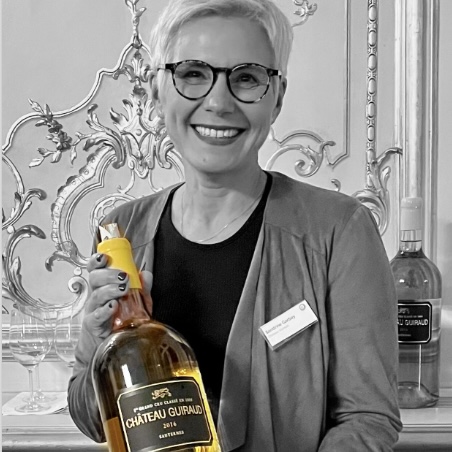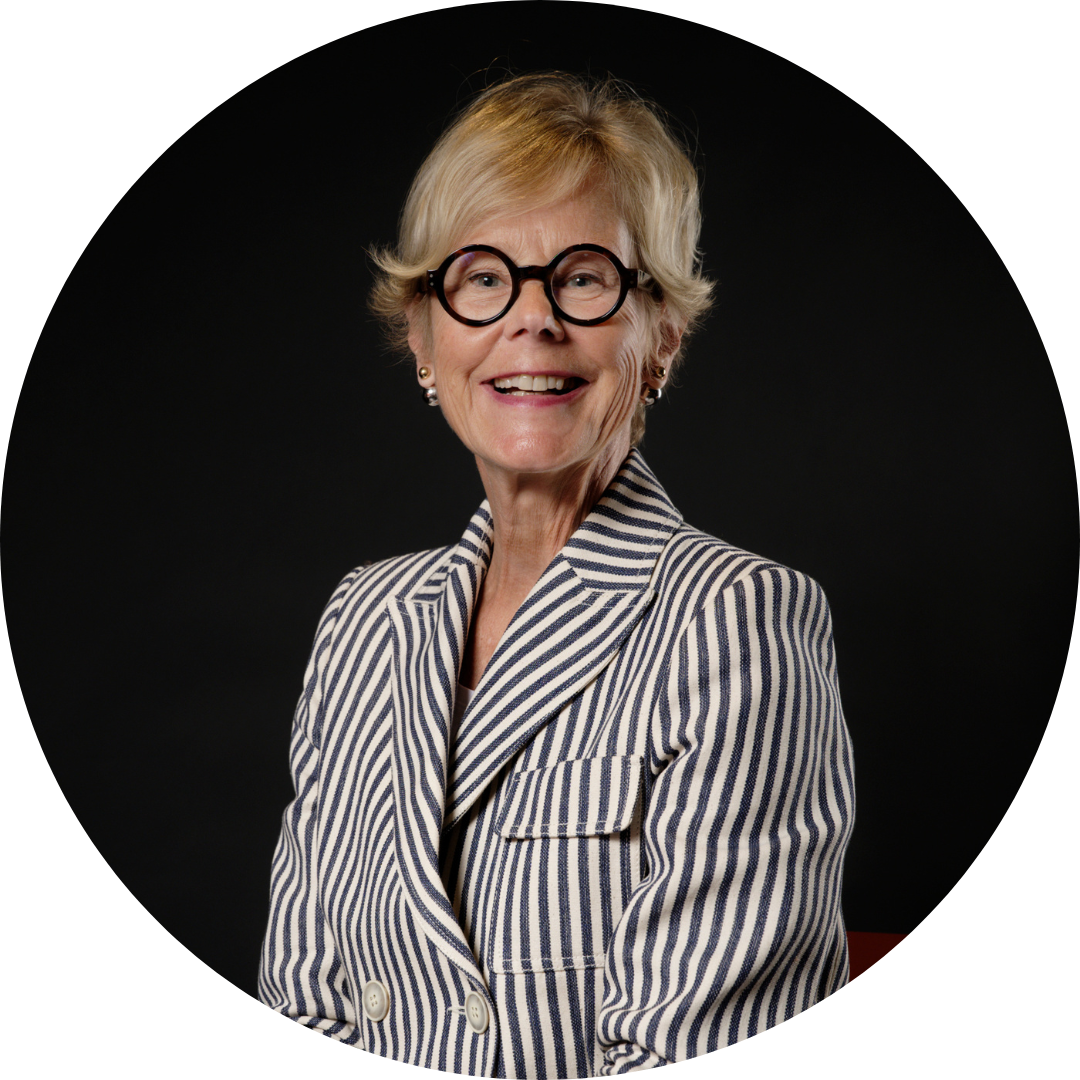Sandrine Garbay
Managing Director
~
Château Guiraud
Premier Cru Classé Barsac Sauternes
Gerda: You’re in charge of the estates owned by Matthieu Gufflet — Château Callac, Château des Bachelards, and Domaine Les Aurelles — but as Managing Director of Château Guiraud, what are the main challenges you face?
Sandrine Garbay: I’m in charge of production, which is at the core of both my profession and my training, but I also oversee the management of the estates, which is a newer aspect for me. Even though I’ve learned a lot over the past three years, it still takes me more time because I’m less experienced in this area. On the production side, the main challenge is securing the harvests, which are essential to economic stability. The Guiraud vineyard is highly exposed to frost, and paradoxically, this risk is heightened by climate change. The vines bud earlier and are therefore more vulnerable in April. We’ve installed frost-protection towers on the best terroirs and adopted later pruning practices. We’ve also been deeply committed to organic farming since 2011—Guiraud was the first certified Premier Cru Classé. Faced with intense downy mildew pressure, we invested in equipment that allows us to treat the entire estate in a single day, with skilled and responsive teams. Thanks to this, we saved the 2024 vintage despite unprecedented pressure and achieved our largest harvest since I arrived. It shows that hard work pays off. In the cellar, we’ve refined our aging choices, particularly regarding barrels, and the upcoming renovation of the building will help us preserve the wines’ freshness even more. We’ve also introduced natural fermentation for the sweet wines, using indigenous yeasts, which enhances the purity and stability of the wine.
I manage four estates, with 35 people at Guiraud and 15 across the other properties. The commercial challenge is significant, especially for Sauternes. Although I was familiar with Bordeaux’s négociant system through promotions, the actual commercial relationship was a real learning experience. The courtier have supported us well, and the arrival of Coralie Bernard to strengthen the sales team has been a great help. In the current context, sales remain a critical issue for all our properties.
The Guiraud Brand: Today & Tomorrow
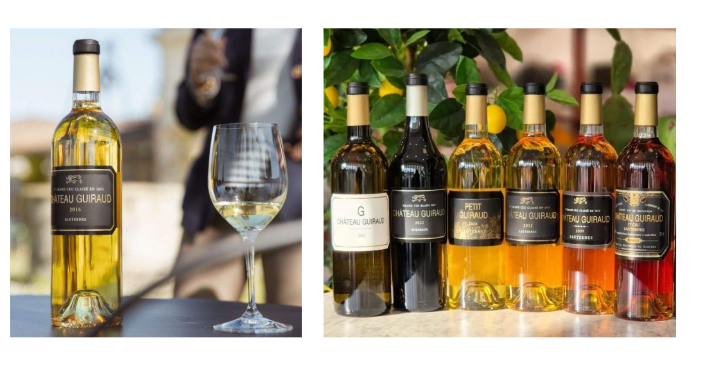 G: What positioning do you envision for your brands?
G: What positioning do you envision for your brands?
SG: We produce four wines at the estate. G de Château Guiraud has become a strong brand, especially present in Bordeaux restaurants. It’s an entry-level wine, distributed through the Place de Bordeaux — about 200,000 bottles a year — which contributes significantly to its visibility.
In 2020, my predecessor launched Château Guiraud’s Grand Vin Blanc Sec — an excellent idea, I must admit. Due to frost, we didn’t produce it in 2021, but as soon as I arrived in 2022, we made the second vintage. This wine, mainly made from Sémillon, fully embodies the identity of Sauternes. I’m very fond of it. Sémillon is the king grape here, and it should remain so. Many producers in Sauternes and Barsac are now working on dry whites made from Sémillon, and I find that very relevant.
G: Should there be an official “Sauternes Blanc Sec” appellation?
SG: Yes, I’m quite in favor of it. Historically, dry whites were part of the appellation. Sweet wines only became dominant at the end of the 18th century and especially in the 19th. Dry whites existed long before. There’s no shame in returning to that tradition. Demand for dry white wines is increasing, and it would allow us to showcase another expression of our terroir — always with a majority of Sémillon. We have both the identity and the quality to justify this appellation, which would give Sauternes more visibility. From an economic standpoint, it would also make sense: right now, these wines contribute to the Bordeaux appellation, but they could instead support the Sauternes AOC. It would be a real asset to elevate our dry whites, but also to shine a light on our sweet wines. I’m convinced the two should go hand in hand, even if the sweet wines remain our core and priority.
G: The National Institute of Origin and Quality (INAO) has already recognized “Médoc Blanc Sec.” Why not here yet ?
SG: Because we haven’t officially started the process. There are still a few reservations among producers; some are unsure about the value of such an appellation. The producers’ union wants to first bring everyone together, explain, and build consensus.
G: Once that appellation exists, the Union des Grands Crus might allow dry whites to be presented at their events?
SG: Exactly. That’s an important goal.
G: What share of your production is dry white?
SG: They account for two-thirds of our volume. Of the estate’s 90 hectares, 40 are dedicated to dry whites and 50 to sweet wines.
G: What makes your wines stand out?
SG: At Guiraud, our grape varieties are part of our DNA: 65% Sémillon and 35% Sauvignon, which is quite rare in Sauternes. It’s historical, and it contributes to the estate’s identity.
For the dry whites, our main asset is our gravelly clay and sandy soils — ideal for delicate, supple Sémillon with charm and density, without the rusticity sometimes found on heavy clay soils in Sauternes. That’s what gives G de Guiraud its unique style: a 50/50 Sémillon-Sauvignon blend, round, smooth, easy-drinking, with nice freshness but not too much tension. That’s its signature, and I’m very attached to it.
G: You mentioned wanting more freshness and tension in Château Guiraud. Can you elaborate?
SG: Yes. Guiraud has long emphasized balanced sweetness. Thanks to Sauvignon, we can fine-tune sugar levels while preserving freshness. I’m careful to avoid excessive concentration, which is more common due to climate change. In 2022, some lots had up to 450 grams of residual sugar per liter in the must — that’s nearly 30% potential alcohol. We chose not to include those in the blend, as they made the wine too heavy. I stand for controlled sweetness and aromatic purity. That’s what our clients appreciate.
At each tasting, “Petit Guiraud,” made from top terroirs but harvested earlier, charms with its freshness and lightness — around 90 grams of residual sugar. It fully expresses the nobility of botrytis without excess. Many people tell me, even after tasting Château Guiraud: “That Petit Guiraud is just so enjoyable.” It clearly shows that finesse and balance matter more than over-concentration today.
G: How do you attract consumers, especially Gen Z, to Sauternes?
SG: Some châteaux have tried the cocktail approach, and that’s one avenue, especially for appealing to younger drinkers. But we need to activate multiple levers. Dry whites are another accessible entry point — ideally, curious consumers will then want to discover our sweet wines. And the final tool is the dining experience. We need to show that our sweet wines can pair with a wide range of dishes, beyond the classic combinations.
All Sauternes estates are working in this direction, but we must admit we still struggle to convince people — even sommeliers. Many say their clients are hesitant. Yet in our restaurant at Guiraud, and at the Cercle de Guiraud, our chef always proposes pairings with Sauternes wines. And it works: we serve an incredible number of glasses and bottles. Of course, visitors are already in the Sauternes mindset, but they genuinely enjoy these often-savory pairings. Sometimes, just opening a bottle or placing it on the table is enough to trigger that first step and shift perceptions.
G: And on wine lists, Sauternes is still too often confined to dessert…
SG: Yes, that’s a real issue. We absolutely need to break out of that limiting view. Change must come from sommeliers — and from the way wine lists are designed.

G: What are your main markets?
SG: Our sales are fairly well balanced: 30% in the United States, 40% in Europe, and 30% in Asia. Guiraud invested early in the Asian market, notably thanks to our brand ambassador, Anne Xavière Vernay, who is based in Australia and covers both Asia and Oceania. She worked a lot in China starting in 2017, but that market nearly came to a halt during the pandemic. We’re hoping for a recovery soon. We’re now developing Southeast Asia, especially the Philippines and Australia. But over the next two to three years, our priority is to refocus on Europe—particularly France—and to reestablish ties with nearby markets that we’ve sometimes overlooked. Spain, the UK, and Germany are central to our strategy, as we’re somewhat behind there.
In France, we have a dedicated sales representative, Etienne d’Hendecourt, who’s working to strengthen our presence in restaurants and wine shops for all four estates in the group. We’re also very eager to grow in Paris—it’s a market in its own right, and we’ve been far too absent there. In Bordeaux, we’re well represented with the G de Guiraud, the Grand Vin, and a great showcase at the brasserie in the Cité du Vin, which our owner took over in 2024 through Latitude Vin.
G: How many négociants from the Place de Bordeaux do you work with?
SG: The Place is still very important to us. We sell about 90% of our wines through the Place and work with an average of 50 négociants—up to 70 for the G de Guiraud. We sell about 10% directly and welcome between 5,000 and 6,000 visitors a year to the estate, which is open seven days a week from April onward.
G: There seems to be a desire from Matthieu Gufflet to take back a part of the distribution directly.
SG: Yes, that’s an important strategic axis—both for image and for boosting sales. Sweet wines are distributed through the Place de Bordeaux, but we want to sell more, and it’s not their top priority. We remain partners with the négociants and are happy to support them, but we also need to develop direct sales in parallel.
G: Let’s say it loud and clear—bravo to Matthieu Gufflet, great French entrepreneur investing in our region.
SG: Yes, and our challenge today is to do the groundwork to increase awareness of our wines and broaden their distribution. We don’t really have a choice. We have a team of four salespeople for the group’s four properties. Three of them work internationally: one in Europe, one in the U.S. (shared with Domaine de Chevalier and Château Canon La Gaffelière), and one in Asia-Oceania. Then there’s Coralie Bernard, who works closely with the Bordeaux négociants. She supports them with our sweet wines—work they can’t always do themselves. Along with Anne Xavière, she identifies new partners and then connects them with the négociants. She doesn’t sell directly. This is a virtuous system: everyone wins. The Bordeaux negoce has incredible strength, a vast network, and impressive logistics. It’s up to us to support them in the commercial work. Guiraud has been doing this for a long time, but over the past three years, we’ve really stepped up our efforts. Now we hope the rest of Bordeaux will follow suit.
G: You’re in direct contact with clients, sommeliers, and consumers—do scores still really matter to them?
SG: For sweet wines, it’s more nuanced and market-dependent. In the U.S., some collectors still care about scores, but it’s not universal. In January, I toured with one of our longtime distributors there—he doesn’t rely on scores at all. He prefers to let the wines speak for themselves. That said, some importers still need them to support their sales, especially when dealing with distributors. But for wine shops, restaurants, or end consumers, scores matter much less now. Social media has really changed the game. The influence of major critics has been diluted. Today, there are so many voices, and a Parker score, for example, doesn’t carry the same weight it once did. Scores are still a reference, of course—but they’re no longer decisive. This is even more true for Bordeaux dry whites. They don’t always receive spectacular scores, yet they sell very well. I’m also thinking of our 2022 sweet wine: it didn’t receive outstanding ratings during the En Primeur tastings. Perhaps that’s because I didn’t explain my approach clearly enough — I focused on preserving freshness rather than pursuing concentration. Compared to richer wines, Guiraud went more unnoticed. So, we need to be more proactive in our communication, and I believe that today, social media is more powerful than scores.
The Business
G: What are your main markets?
SG: Our sales are fairly well balanced: 30% in the United States, 40% in Europe, and 30% in Asia. Guiraud invested early in the Asian market, notably thanks to our brand ambassador, Anne Xavière Vernay, who is based in Australia and covers both Asia and Oceania. She worked a lot in China starting in 2017, but that market nearly came to a halt during the pandemic. We’re hoping for a recovery soon. We’re now developing Southeast Asia, especially the Philippines and Australia. But over the next two to three years, our priority is to refocus on Europe—particularly France—and to reestablish ties with nearby markets that we’ve sometimes overlooked. Spain, the UK, and Germany are central to our strategy, as we’re somewhat behind there.
In France, we have a dedicated sales representative, Etienne d’Hendecourt, who’s working to strengthen our presence in restaurants and wine shops for all four estates in the group. We’re also very eager to grow in Paris—it’s a market in its own right, and we’ve been far too absent there. In Bordeaux, we’re well represented with the G de Guiraud, the Grand Vin, and a great showcase at the brasserie in the Cité du Vin, which our owner took over in 2024 through Latitude Vin.
G: How many négociants from the Place de Bordeaux do you work with?
SG: The Place is still very important to us. We sell about 90% of our wines through the Place and work with an average of 50 négociants—up to 70 for the G de Guiraud. We sell about 10% directly and welcome between 5,000 and 6,000 visitors a year to the estate, which is open seven days a week from April onward.
G: There seems to be a desire from Matthieu Gufflet to take back a part of the distribution directly.
SG: Yes, that’s an important strategic axis—both for image and for boosting sales. Sweet wines are distributed through the Place de Bordeaux, but we want to sell more, and it’s not their top priority. We remain partners with the négociants and are happy to support them, but we also need to develop direct sales in parallel.
G: Let’s say it loud and clear—bravo to Matthieu Gufflet, great French entrepreneur investing in our region.
SG: Yes, and our challenge today is to do the groundwork to increase awareness of our wines and broaden their distribution. We don’t really have a choice. We have a team of four salespeople for the group’s four properties. Three of them work internationally: one in Europe, one in the U.S. (shared with Domaine de Chevalier and Château Canon La Gaffelière), and one in Asia-Oceania. Then there’s Coralie Bernard, who works closely with the Bordeaux négociants. She supports them with our sweet wines—work they can’t always do themselves. Along with Anne Xavière, she identifies new partners and then connects them with the négociants. She doesn’t sell directly. This is a virtuous system: everyone wins. The Bordeaux negoce has incredible strength, a vast network, and impressive logistics. It’s up to us to support them in the commercial work. Guiraud has been doing this for a long time, but over the past three years, we’ve really stepped up our efforts. Now we hope the rest of Bordeaux will follow suit.
G: You’re in direct contact with clients, sommeliers, and consumers—do scores still really matter to them?
SG: For sweet wines, it’s more nuanced and market-dependent. In the U.S., some collectors still care about scores, but it’s not universal. In January, I toured with one of our longtime distributors there—he doesn’t rely on scores at all. He prefers to let the wines speak for themselves. That said, some importers still need them to support their sales, especially when dealing with distributors. But for wine shops, restaurants, or end consumers, scores matter much less now. Social media has really changed the game. The influence of major critics has been diluted. Today, there are so many voices, and a Parker score, for example, doesn’t carry the same weight it once did. Scores are still a reference, of course—but they’re no longer decisive. This is even more true for Bordeaux dry whites. They don’t always receive spectacular scores, yet they sell very well. I’m also thinking of our 2022 sweet wine: it didn’t receive outstanding ratings during the En Primeur tastings. Perhaps that’s because I didn’t explain my approach clearly enough — I focused on preserving freshness rather than pursuing concentration. Compared to richer wines, Guiraud went more unnoticed. So, we need to be more proactive in our communication, and I believe that today, social media is more powerful than scores.
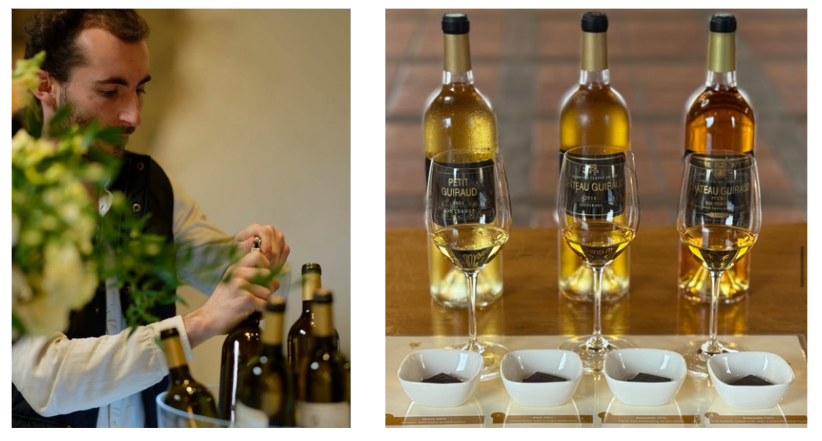
Distribution Today & Tomorrow
G: How do you assess the current state of the market?
SG: 2024 has been a tough year for everyone, but Sauternes has held up better than other Bordeaux appellations. Thanks to the renewed dynamism in the region, we’re getting more visibility and welcoming many visitors.
G: You’ve really done a fantastic job in the appellation. The châteaux are open, there’s a great culinary offering, and the region is stunning.
SG: Yes, absolutely. All of that helped soften the blow of 2024, a year when wine sales suddenly came to a halt. Staying closely connected with our end customers—wine lovers who visit us—has helped us weather this difficult year better than others. Our appellation is suffering less than many others in Bordeaux. We’ve managed to mitigate some of the effects of this changing market. In Sauternes, this market shift started a few years ago. When we faced the challenge of selling sweet wines, we had no choice but to reinvent ourselves—to find new ways to attract the public, through wine tourism, estate hospitality, and the region’s restaurants. These have all become showcases to bring in new ambassadors and promote our wines. Everyone who experiences Sauternes—whether it’s at Lafaurie-Peyraguey, d’Yquem, or the Maison de Sauternes—leaves convinced. We have to keep building on that momentum.
G: Are these difficulties cyclical or structural?
SG: The challenges are both cyclical and structural. Cyclical, because the market is currently waiting to see how things evolve in the United States, particularly with the possibility of new tariffs, which is weighing on trade. The situation is also tough in Asia, especially in China. Structurally, we need to rethink our distribution model. Is the En Primeur system still relevant? In 2023, we sold 25% of Guiraud as En Primeur. Perhaps we could shift that “momentum” to another time of year. Olivier Poussier suggested in La Revue du Vin de France transforming En Primeur Week into a week for tasting bottled, ready-to-ship wines. Why not? It would allow people to discover the finished vintage instead of participating in a futures campaign. But if the model is to evolve, it must be done on a global scale, with the support of institutions like the Union des Grands Crus or the CIVB. That’s crucial for our economic balance. As Jean-Guillaume Prats pointed out, the market is changing, and we have to adapt. Globalization and the growing demand for diverse wines create an environment where it’s difficult to stick to a single model. Consumers are now more versatile, and this forces us to rethink our place in the market. Sauternes has always maintained a fair and steady pricing position, without excessive fluctuation from one vintage to another. That deserves to be better recognized. We’ve stayed closely connected to our market, never straying too far from the consumer’s expectations. And yet, our production costs are high, with low yields and labor-intensive harvests.
Today, Sauternes’ Classified Growths offer the best quality-to-price ratio in Bordeaux. Our sweet wines aren’t expensive — not really. But, as Bernard Arnault once said, you have to create desirability. We must find the right keys to make our wines attractive and desirable to consumers.
The Harvest 2024
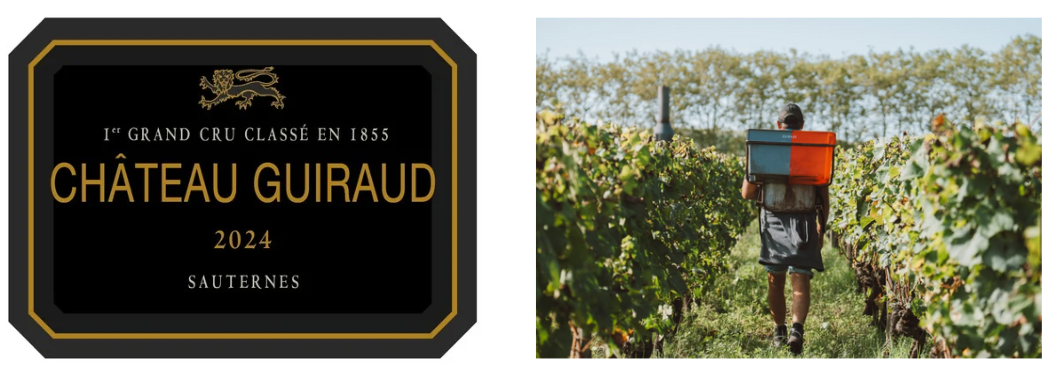
G: Could you say a few words about the harvest and your impressions of the vintage quality?
SG: 2024 was a year full of challenges. We had a lot of rain, which put considerable pressure on the vines, especially with the risk of diseases. Temperatures were relatively warm, and combined with the rain, vegetation grew abundantly, leading to strong pressure from mildew. It was a real viticultural challenge, and our teams worked tirelessly to maintain good vine health while guiding the grapes towards beautiful ripeness.
G: You must have had some sleepless nights?
SG: Yes, definitely… We were very worried when the first signs of mildew appeared early in the season, as early as May. We thought, “This will never hold.” Once mildew is established, it’s too late to act, but thanks to several copper treatments, we managed to control it. In the end, we harvested a good quantity of quality grapes. The late season helped preserve acidity in the grapes. I already said this about 2023, and I repeat it for 2024: we have two quite incredible white vintages. Of course, 2023 is slightly superior, both for dry and sweet wines, but I’m really satisfied with the 2024 vintage. What still amazes me is how noble rot developed despite the wet weather. We had alternating periods of rain and sunshine, which allowed the grapes to dry and be harvested in good conditions. Everything went very well thanks to our teams. We worked with 100 harvesters, including 80 from outside and 20 permanent team members.
G: How many sorting passes did you do?
SG: We did four full passes, and in the end, the harvest turned out to be of very good quality. Even though it doesn’t have the richness of 2022 or 2023, there’s a lovely balance between acidity and sweetness, with the DNA of noble rot and notes of confit. We’re very happy with the result.
G: And what about the dry white?
SG: This year, noble rot set in very early, which made the harvest a bit more rushed. It was a real race against time to pick healthy grapes before the rot attacked. Our 2024 G de Guiraud, from a parcel selection, is a bit atypical this year because it is composed of 70% Sauvignon and 30% Sémillon, whereas the usual blend is 50% Sauvignon and 50% Sémillon. Unfortunately, we couldn’t harvest the Sémillon in time—they rotted quite early. The Sauvignon grapes were generous in quantity, which slightly altered the usual balance. But it’s also interesting to have a somewhat different vintage.
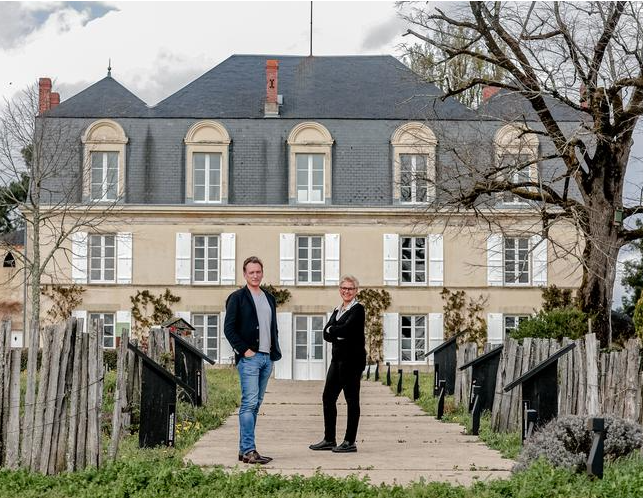
G: You work for and with a major French entrepreneur, Matthieu Gufflet. Can you tell me a bit about your collaboration?
SG: I’m in direct contact with him, and he’s truly passionate about wine. It’s fascinating to work with someone so entrepreneurial.He’s aiming for vertical integration, bringing together all parts of the value chain that can support the marketing of our wines. His long-term vision impresses me tremendously. He’s able to project himself far ahead — he’s a true visionary. As for me, I’m more focused on production, with a short- to medium-term outlook. We complement each other well, because both perspectives are essential for managing a vineyard properly. I’m learning a great deal working alongside him.
Gerda BEZIADE has an incredible passion for wine, and possesses a perfect knowledge of Bordeaux acquired within prestigious wine merchants for 25 years. Gerda joins Roland Coiffe & Associés in order to bring you, through “Inside La PLACE” more information about the estate we sell.

